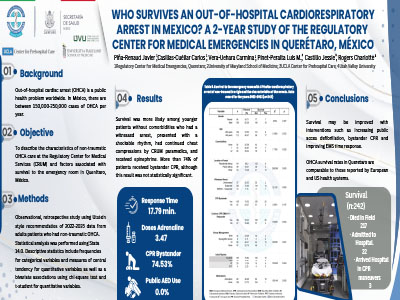Who Survives an Out-of-Hospital Cardiorespiratory Arrest In Mexico? A 2-Year-Study of the Regulatory Center for Medical Emergencies in Queretaro
Author: Javier Piña Renaud, Carlos Casillas Cuellar, Carmina Vera-Uehara, Luis M. Pinet-Peralta, Jessie Castillo, and Charlotte Rogers | |
Associate Authors:
<p><strong>Introduction:</strong></p>
<p>Out-of-hospital cardiac arrest (OHCA) is a global health problem, with survival rates varying greatly between countries. Survival to the emergency room of OHCA patients requires a coordinated set of actions, including immediate recognition of cardiac arrest, activation of the emergency medical services (EMS), early cardiopulmonary resuscitation (CPR), rapid defibrillation, and effective Advanced Life Support (ALS). There are few existing reports in Mexico concerning OHCA and survival rates at arrival to the hospital.</p>
<p><strong>Objective:</strong></p>
<p>To collect, identify, analyze, and describe the most important circumstances and determinants of out-of-hospital care during cases of cardiac arrest and its influence on survival to the emergency room in Querétaro, Mexico.</p>
<p><strong>Methods:</strong></p>
<p>An observational, descriptive, and retrospective study was conducted in 2022 and 2023. The study included patients with confirmed cardiac arrest (CA) and CPR performed, attended by the ALS units of the Regulatory Center for Medical Emergencies in Queretaro. Main variables of interest included age, sex, place, witnessed CA, bystander-initiated CPR, initial rhythm, tracheal intubation, medication provided, return of spontaneous circulation (ROSC), response time, and survival. Statistical analyses included frequencies and odds ratios with 95% confidence intervals.</p>
<p><strong>Results:</strong></p>
<p>The study examined the records of 320 patients. Of those, 65% were men, the average age was 60 years, 70% experienced the cardiac arrest at home, and 50% were witnessed CA. CPR was initiated by bystander in 20% of the patients, 25% had an initial shockable rhythm, 10% received ALS, and 5% survived at arrival to the emergency room. The average EMS response time was 25 minutes.</p>
<p><strong>Conclusions:</strong></p>
The rates of survival of OHCA in Queretaro are extremely low. These findings have important implications for practice. In particular, they can be used to improve the efficiency of prearrival care such as community initial response and use of a public-access automatic external defibrillators (AEDs). Reducing EMS response times is essential; nevertheless, bystander-initiated CPR is the most important intervention to reduce mortality in OHCA.
|
|
|
|

